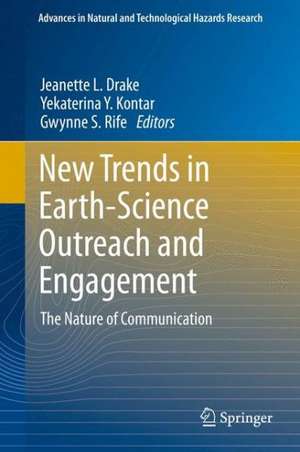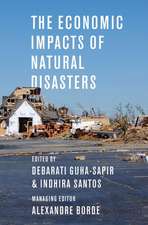New Trends in Earth-Science Outreach and Engagement: The Nature of Communication: Advances in Natural and Technological Hazards Research, cartea 38
Editat de Jeanette L. Drake, Yekaterina Y. Kontar, Gwynne S. Rifeen Limba Engleză Hardback – 27 dec 2013
Book chapters come from some 40 authors who are geophysical scientists, social scientists, educators, scholars, and professionals in the field. Bringing diverse perspectives, these authors hail from universities, and research institutes, government agencies, non-profit associations, and corporations. They represent multiple disciplines, including geosciences, education, climate science education, environmental communication, and public policy. They come from across the United States and around the world. Arranged into five sections, the book looks at geosciences communication in terms of:
1) Education
2) Risk management
3) Public discourse
4) Engaging the public
5) New media
From case studies and best practices to field work and innovations, experts deliver pragmatic solutions and delve into significant theories, including diffusion, argumentation, and constructivism, to name a few.
Intended for environmental professionals, researchers, and educators in the geophysical and social sciences, the book emphasizes communication principles and practices within an up-to-the-minute context of new environmental issues, new technologies, and a new focus on resiliency.
| Toate formatele și edițiile | Preț | Express |
|---|---|---|
| Paperback (1) | 639.25 lei 6-8 săpt. | |
| Springer International Publishing – 23 aug 2016 | 639.25 lei 6-8 săpt. | |
| Hardback (1) | 649.06 lei 6-8 săpt. | |
| Springer International Publishing – 27 dec 2013 | 649.06 lei 6-8 săpt. |
Din seria Advances in Natural and Technological Hazards Research
- 18%
 Preț: 977.97 lei
Preț: 977.97 lei - 18%
 Preț: 921.15 lei
Preț: 921.15 lei - 18%
 Preț: 1406.35 lei
Preț: 1406.35 lei - 18%
 Preț: 788.72 lei
Preț: 788.72 lei - 15%
 Preț: 643.84 lei
Preț: 643.84 lei - 18%
 Preț: 955.56 lei
Preț: 955.56 lei - 18%
 Preț: 954.31 lei
Preț: 954.31 lei - 18%
 Preț: 958.56 lei
Preț: 958.56 lei - 18%
 Preț: 937.56 lei
Preț: 937.56 lei - 18%
 Preț: 952.72 lei
Preț: 952.72 lei -
 Preț: 382.18 lei
Preț: 382.18 lei - 15%
 Preț: 647.92 lei
Preț: 647.92 lei - 18%
 Preț: 948.47 lei
Preț: 948.47 lei - 15%
 Preț: 640.06 lei
Preț: 640.06 lei -
 Preț: 407.01 lei
Preț: 407.01 lei - 15%
![Submarine Mass Movements and Their Consequences [With CDROM]](https://i4.books-express.ro/bs/9781402012440/submarine-mass-movements-and-their-consequences-with-cdrom.jpg) Preț: 604.37 lei
Preț: 604.37 lei - 15%
 Preț: 643.48 lei
Preț: 643.48 lei - 15%
 Preț: 648.05 lei
Preț: 648.05 lei - 18%
 Preț: 1236.99 lei
Preț: 1236.99 lei - 18%
 Preț: 947.35 lei
Preț: 947.35 lei - 18%
 Preț: 947.35 lei
Preț: 947.35 lei - 18%
 Preț: 966.15 lei
Preț: 966.15 lei - 15%
 Preț: 642.51 lei
Preț: 642.51 lei - 18%
 Preț: 951.29 lei
Preț: 951.29 lei - 18%
 Preț: 1255.16 lei
Preț: 1255.16 lei - 15%
 Preț: 642.51 lei
Preț: 642.51 lei - 15%
 Preț: 646.43 lei
Preț: 646.43 lei - 15%
 Preț: 635.96 lei
Preț: 635.96 lei - 18%
 Preț: 1244.08 lei
Preț: 1244.08 lei
Preț: 649.06 lei
Preț vechi: 763.60 lei
-15% Nou
Puncte Express: 974
Preț estimativ în valută:
124.20€ • 132.81$ • 103.55£
124.20€ • 132.81$ • 103.55£
Carte tipărită la comandă
Livrare economică 17 aprilie-01 mai
Preluare comenzi: 021 569.72.76
Specificații
ISBN-13: 9783319018201
ISBN-10: 3319018205
Pagini: 280
Ilustrații: XXVIII, 244 p. 49 illus., 47 illus. in color.
Dimensiuni: 155 x 235 x 20 mm
Greutate: 0.66 kg
Ediția:2014
Editura: Springer International Publishing
Colecția Springer
Seria Advances in Natural and Technological Hazards Research
Locul publicării:Cham, Switzerland
ISBN-10: 3319018205
Pagini: 280
Ilustrații: XXVIII, 244 p. 49 illus., 47 illus. in color.
Dimensiuni: 155 x 235 x 20 mm
Greutate: 0.66 kg
Ediția:2014
Editura: Springer International Publishing
Colecția Springer
Seria Advances in Natural and Technological Hazards Research
Locul publicării:Cham, Switzerland
Public țintă
Professional/practitionerCuprins
Preface.- Acknowledgements.- Foreword.- Part I – Framing Climate Change.- 1 Assessing Corporate Influence on Climate Change Dialogue.- 2 Reaching Out Beyond the “Usual Suspects” and Traditional Media.- 3 Investigating the Connections Between Oil and Gas Industry Affiliation and Climate Change Concerns.- Part II – The Role of Science in the Conversation.- 4 Science Communication and the Legal System .- 5 Reduction of Conflicts in Mining Using Good Neighbor Agreements.- 6 Science Communication and Tension Between Evidence-Based and Inclusive Features of Policy Making.- 7 Science Communication and Role of Scientists in Public Discussion.- Part III – Friending Earth via Social Media.- 8 Transmedia Storytelling in Science Communication.- 9 Interpreting Earth Science in a Museum Environment.- 10 Impacts of Geospatial Information for Decision Making.- Part IV – STEMming the Tide of Science Illiteracy.- 11 Infusing Climate and Energy Literacy Throughout the Curriculum.- 12 Enticing Students to Pursue STEM-related Careers Through Cyber-Driven Learning.- 13 Writing Assignments in Disguise: Lessons Learned Using Video Projects in the Classroom.- Part V – Organization for Resources and Resiliency.- 14 Stakeholder-Driven Research for Climate Adaptation in New York City.- 15 Funding of Geosciences: Coordinating National and International Resources.- 16 A Real-Time Data Product Creation and Distribution System: Bringing Big Data’s Benefit to the Public.- 17 Trusted Sources: The Role Scientific Societies Play in Informing Public.
Textul de pe ultima copertă
Perhaps just as perplexing as the biggest issues at the core of Earth science is the nature of communicating about nature itself. New Trends in Earth-Science Outreach and Engagement: The Nature of Communication examines the processes of communication necessary in bridging the chasm between climate change and natural hazard knowledge and public opinion and policy. At this junction of science and society, 17 chapters take a proactive and prescriptive approach to communicating with the public, the media, and policy makers about the importance of Earth science in everyday life.
Book chapters come from some 40 authors who are geophysical scientists, social scientists, educators, scholars, and professionals in the field. Bringing diverse perspectives, these authors hail from universities, and research institutes, government agencies, non-profit associations, and corporations. They represent multiple disciplines, including geosciences, education, climate science education, environmental communication, and public policy. They come from across the United States and around the world. Arranged into five sections, the book looks at geosciences communication in terms of:
1) Education
2) Risk management
3) Public discourse
4) Engaging the public
5) New media
From case studies and best practices to field work and innovations, experts deliver pragmatic solutions and delve into significant theories, including diffusion, argumentation, and constructivism, to name a few.
Intended for environmental professionals, researchers, and educators in the geophysical and social sciences, the book emphasizes communication principles and practices within an up-to-the-minute context of new environmental issues, new technologies, and a new focus on resiliency.
Book chapters come from some 40 authors who are geophysical scientists, social scientists, educators, scholars, and professionals in the field. Bringing diverse perspectives, these authors hail from universities, and research institutes, government agencies, non-profit associations, and corporations. They represent multiple disciplines, including geosciences, education, climate science education, environmental communication, and public policy. They come from across the United States and around the world. Arranged into five sections, the book looks at geosciences communication in terms of:
1) Education
2) Risk management
3) Public discourse
4) Engaging the public
5) New media
From case studies and best practices to field work and innovations, experts deliver pragmatic solutions and delve into significant theories, including diffusion, argumentation, and constructivism, to name a few.
Intended for environmental professionals, researchers, and educators in the geophysical and social sciences, the book emphasizes communication principles and practices within an up-to-the-minute context of new environmental issues, new technologies, and a new focus on resiliency.
Caracteristici
Up-to-the-minute context of environmental hazards, new technologies & political landscape By geoscientists for geoscientists working with social scientists and communication principles Underpinned by key communication theories and interspersed with pragmatic solutions Crosses traditional boundaries: international, interdisciplinary, theoretical/applied



